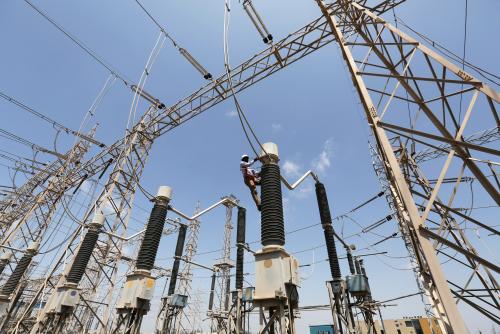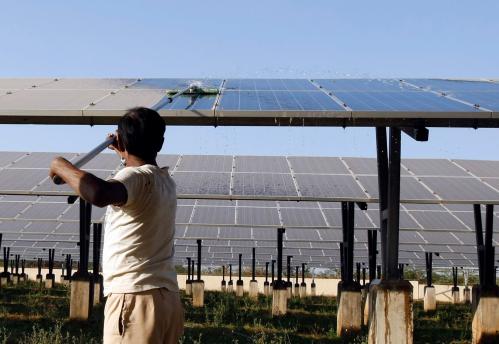Content from the Brookings Institution India Center is now archived. After seven years of an impactful partnership, as of September 11, 2020, Brookings India is now the Centre for Social and Economic Progress, an independent public policy institution based in India.
What is the value of saving one unit (or kilowatt-hour, kWh) of electricity? Most households would think about their bill, and then try and recall what they pay for electricity. What a large number of consumers don’t always realize is they pay a regulator-approved price that varies with their level of consumption, or slab. The more one consumes, the higher the cost for such power. Is this just progressive if not re-distributive pricing?
Turns out, it can be highly efficient. While costs of supplying power to a consumer fall the more they consume, this is inherently true only for a type (size) of connection. Industry which connects at Extra High Voltage (EHV) levels should pay less than low voltage industrial consumption. But if one consumes more, and the utility providing power has to procure more from generators, the next unit of power they buy will typically be more expensive than the previous one(s). Stated another way, from a generation perspective, there is only so much “cheap power” to be made available, from local/cheaper/amortized sources – at any single instance in time, additional power means more and more expensive plants will be required. This is inherently the concept of “peak power”. Unfortunately, utilities in India don’t procure enough peak power – they cut off consumers through feeder-level load-shedding.
For paying households, beyond fixed charges based on the size of the connection, at the lowest end, electricity could be as cheap as a rupee/unit, and at the higher end, some 7 or 8 rupees (or more). Residential consumers pay an average of Rs. 3.2/kWh,[1] but because of the tariff slabs, saving a kilowatt-hour is worth far more than one’s average cost.
BUT, if one poses the same question to a utility (Discom) head, “What’s it worth to save one unit of power?”, whether through Demand Side Management, or a Smart Grid/Demand Response, or a consumer Roof-top Solar panel, etc., the answer is invariably the average cost of power, or the book value paid by the utility, somewhere close to Rs. 3.5/kWh. The value is the state-wide average, derived by taking the total monthly expenditure on power purchases (or procurement) and dividing by the total kWh purchased. What utilities should be focusing on is their marginal cost of power procurement, or so-called “costly power”, which could range from IPP power, to short-term purchases such as from the power exchange, to Central Generational Station UI charges (Unscheduled Interchange, the surcharge based on deviation from the schedule as well as the frequency of the grid, with a lower frequency commensurate with greater imbalance). These can be well over Rs. 10-14/kWh!
Electricity must always be in balance, since alternating current cannot easily be stored. Not only does demand vary by time of day (or season), supplies also vary. Even with generation stations under human control (which can be despatched), plants and transmission lines can fail or require repair, and most renewables are inherently variable. “Thus, while we (today) think of electricity like selling fruit (Rs./kWh), the basket we sell is actually a mix of apples, oranges, lychees, mangoes, etc. each with different cost and other characteristics. Blending the supply as per their respective shares may work from an accounting perspective, but it masks important signaling about marginal costs as well as other characteristics of the power.” (R. Tongia, Yojana Magazine, Planning Commission, Dec. 2013).
Time if day pricing is not only micro-economically efficient, it is also fair – why should someone not contributing to the peak pay for it? With time of day pricing, we will also take steps towards ending shortfalls and load-shedding. At the demand side, consumers will have incentives to reduce peak consumption, and higher per unit procurement pricing will give signals for proper peaking plants, ones that can ramp up and down quickly, and ones most economic for operating just a few hundred or a thousand hours per year.
Consumer Time of Day pricing will take a long time to implement, since it requires new metering infrastructure. We must start wherever we are replacing older meters. The lower hanging fruit will be bulk (utility) procurement, where today most power purchase agreements (PPAs) are flat-rate, regardless of power delivery at 7 PM (the peak) or 5 AM. Instead of just worrying about a single number for “cost of power” – procurement must quantify and monetize additional factors such as geography, import implications, environmental impact, etc. Time of day is just a first step towards a more dynamic, nimble, and even smarter grid.
Image credits: Sankarshan Mukhopadhyay
[1] 2012 Annual Plan per the Planning Commission’s 2011-12 Workings of State Power Utilities








Commentary
Op-edTime of day electricity pricing: From utilities to consumers
May 7, 2014